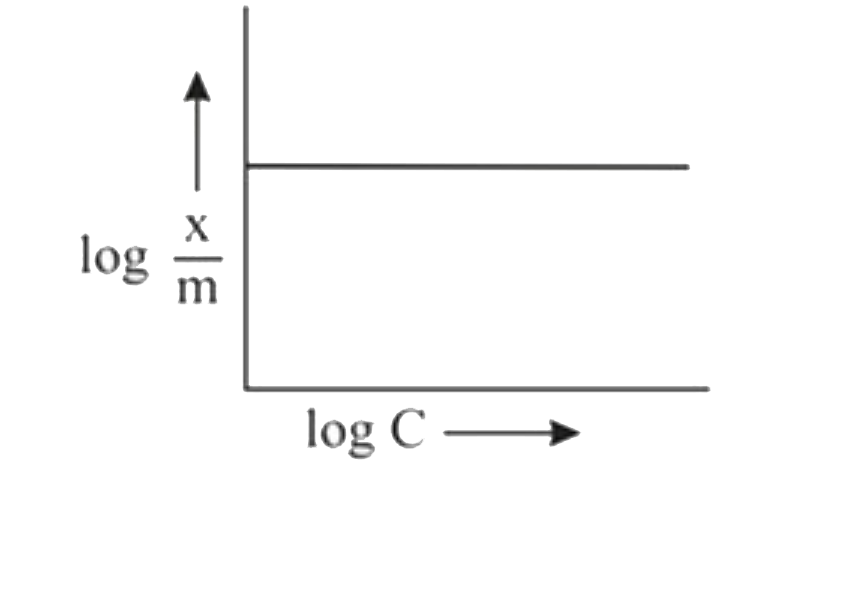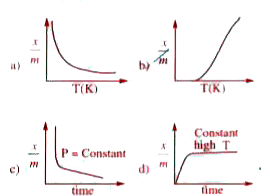xm=KC1/n where C= Concentration of a m solution, x = wt of adsorbed solute m =Wt of adsorbent. The equation represents - Solution in Telugu
Langmuir adsorption isotherm
Freundlich adsorption isotherm
Arhenius equation
Chemi sorption isotherm
The correct Answer is:B
Step by step video, text & image solution for (x)/(m)=KC^(1//n) where C = Concentration of a m solution, x = wt of adsorbed solute m =Wt of adsorbent. The equation represents - by Chemistry experts to help you in doubts & scoring excellent marks in Class 12 exams.
Topper's Solved these Questions
- BOOK - AAKASH SERIESCHAPTER - SURFACE CHEMISTRYEXERCISE - OBJECTIVE EXERCISE - 1 (CATALYSIS)20videos
SURFACE CHEMISTRY
- BOOK - AAKASH SERIESCHAPTER - SURFACE CHEMISTRYEXERCISE - OBJECTIVE EXERCISE - 1 (COLLOIDS)31videos
SURFACE CHEMISTRY
- BOOK - AAKASH SERIESCHAPTER - SURFACE CHEMISTRYEXERCISE - SUBJECTIVE EXERCISE - 4 (VERY SHORT ANSWER QUESTIONS)5videos
SURFACE CHEMISTRY
- BOOK - AAKASH SERIESCHAPTER - STOICHIOMETRYEXERCISE - PRACTICE SHEET (ADVANCED) (INTEGER TYPE QUESTION)2videos
STOICHIOMETRY
- BOOK - AAKASH SERIESCHAPTER - VA GROUP ELEMENTSEXERCISE - PRACTICE EXERCISE51videos
VA GROUP ELEMENTS
Similar Questions
A catalyst
03:08View Solution(A) : Colloid is a heterogenous system
(R): Colloidal particles have an enormous surface area per gram as a result of their small sizeView SolutionWhat is a micelle? Give an example of micelle formation.
07:23View SolutionAmmonia is oxised by oxygen to give nitric oxide and water. The weight of water produced per gram of nitric oxide is 0.1×xg. What is value of d.
View SolutionWhich of the following reacts rapidly with oxygen in the air at ordinary temperature?
02:04View SolutionThe mass a of the solute adsorbed per gram, pf splid adsorbent occurs by Freundlich's isotherm, i.e., a = KC^(n) , where k and n are 0.160 and 0.431 respectively Calculate the moles of acetic acid (molecular mass = 60.05 gmol ) that 1 kg of charcoal would adsorb from a 0.837 M Vinegar solution.
02:56View Solutionनिम्न में से कौन-सा ग्राफ रासायनिक अधिशोषण के लिए है, जहा x गैस की वह मात्रा है जो अधिशोषक के m द्रव्यमान पर ताप T पर अधिशोषित होती है ?
02:08View SolutionApplying Freundlich adsorptin isotherm, calculate the amount of acetic acid adsorbed by 1 kg of blood charcoal at 25∘C from a 5% vinegar solution (mass/volume). Given that if the concentration is expressed in molarity (mol dm−3), x/m is mass of the solute adsorbed per gram of adsorbent, then k=0.160andn=2.32.
02:56View SolutionThe number of solutions of the equation n−|x||m−|x∣∣=1 (where m,n>1 and n>m) is
02:56View SolutionThe degree of adsorption of solution on solid surface depends on concentration of solution xm=KC1n
In which of the conditions, we get following type of graph?
 01:54View Solution
01:54View SolutionThe following are some statements about adsorption of solutes from the solutions. A) Increase in the surface area of the adsorbent increases the extent of adsorption. B) Increase in temperature decreases the extent of adsorption. C) The extent of adsorption (x/m) is related to the molar concentration of solution ( c) is given by x//m = k.c^(1//n) The correct combination is
04:23View Solutionxm=KC1/n where C= Concentration of a m solution, x = wt of adsorbed solute m =Wt of adsorbent. The equation represents -
04:23View SolutionThe following are some statements about adsorption of solutes from the solutions.
A) Increase in the surface area of the adsorbent increases the extent of adsorption.
B) Increase in temperature decreases the extent of adsorption.
C) The extent of adsorption (x/m) is related to the molar concentration of solution ( c) is given by x/m=k.c1/n
The correct combination is03:22View SolutionThe following are some statements about adsorption of solutes from the solutions.
A) Increase in the surface area of the adsorbent increases the extent of adsorption.
B) Increase in temperature decreases the extent of adsorption.
C) The extent of adsorption (x/m) is related to the molar concentration of solution ( c) is given by x/m=k.c1/n
The correct combination is02:23View SolutionWhich of the following represents chemisorption ? (x = The mass of the absorbate, m = Mass of the adsorbent)
 03:45View Solution
03:45View Solution

